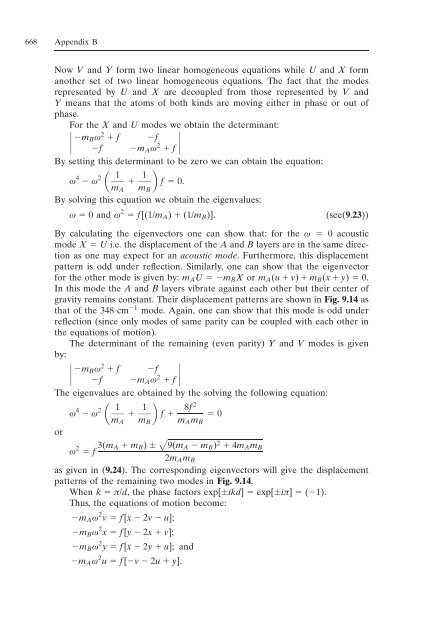10. Appendix
Create successful ePaper yourself
Turn your PDF publications into a flip-book with our unique Google optimized e-Paper software.
668 <strong>Appendix</strong> B<br />
Now V and Y form two linear homogeneous equations while U and X form<br />
another set of two linear homogeneous equations. The fact that the modes<br />
represented by U and X are decoupled from those represented by V and<br />
Y means that the atoms of both kinds are moving either in phase or out of<br />
phase.<br />
For<br />
<br />
the X and U modes we obtain the determinant:<br />
<br />
<br />
mBˆ2 f f<br />
f mAˆ2 <br />
<br />
<br />
f <br />
By setting this determinant to be zero we can obtain the equation:<br />
ˆ 4 ˆ 2<br />
<br />
1<br />
<br />
mA<br />
1<br />
<br />
f 0.<br />
mB<br />
By solving this equation we obtain the eigenvalues:<br />
ˆ 0 and ˆ 2 f [(1/mA) (1/mB)]. (see(9.23))<br />
By calculating the eigenvectors one can show that: for the ˆ 0 acoustic<br />
mode X U i.e. the displacement of the A and B layers are in the same direction<br />
as one may expect for an acoustic mode. Furthermore, this displacement<br />
pattern is odd under reflection. Similarly, one can show that the eigenvector<br />
for the other mode is given by: mAU mBX or mA(u v) mB(x y) 0.<br />
In this mode the A and B layers vibrate against each other but their center of<br />
gravity remains constant. Their displacement patterns are shown in Fig. 9.14 as<br />
that of the 348 cm 1 mode. Again, one can show that this mode is odd under<br />
reflection (since only modes of same parity can be coupled with each other in<br />
the equations of motion).<br />
The determinant of the remaining (even parity) Y and V modes is given<br />
by: mBˆ 2 f f<br />
f mAˆ 2 f<br />
<br />
<br />
<br />
<br />
The eigenvalues are obtained by the solving the following equation:<br />
ˆ 4 ˆ 2<br />
<br />
1<br />
<br />
mA<br />
1<br />
<br />
2 8f<br />
f 0<br />
mB mAmB<br />
or<br />
ˆ 2 f 3(mA mB) ± 9(mA mB) 2 4mAmB<br />
2mAmB<br />
as given in (9.24). The corresponding eigenvectors will give the displacement<br />
patterns of the remaining two modes in Fig. 9.14.<br />
When k apple/d, the phase factors exp[±ikd] exp[±iapple] (1).<br />
Thus, the equations of motion become:<br />
mAˆ 2 v f [x 2v u];<br />
mBˆ 2 x f [y 2x v];<br />
mBˆ 2 y f [x 2y u]; and<br />
mAˆ 2 u f [v 2u y].










